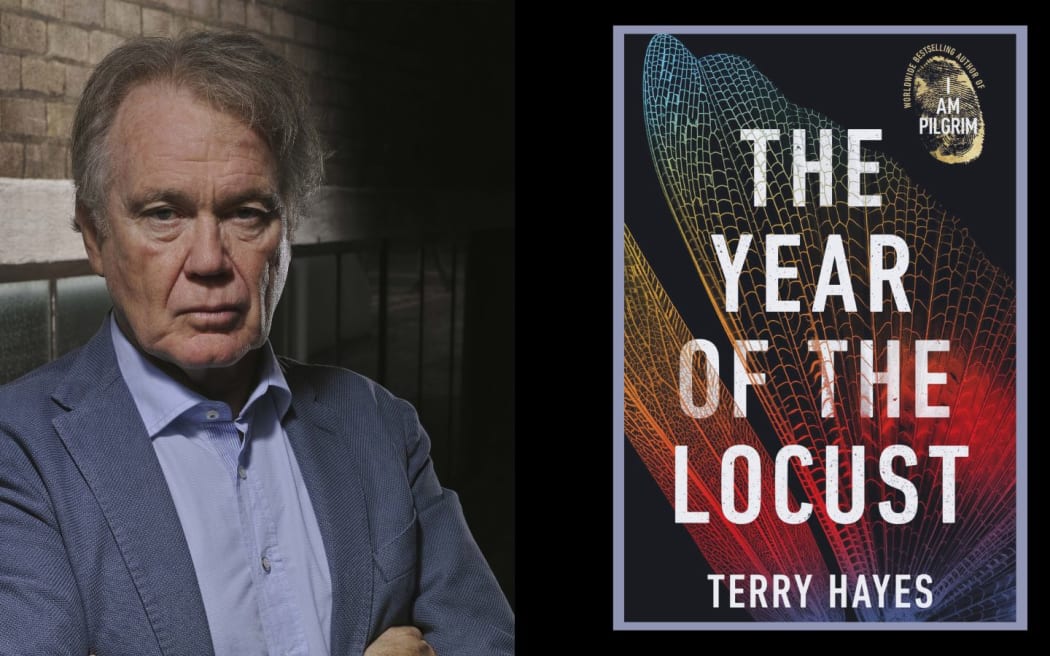In 2013, everyone was reading I am Pilgrim, a gripping spy novel that quickly became a worldwide bestseller. Nine years later, author Terry Hayes is offering his readers a follow up: The Year of the Locust.
His new book is also set in the world of intelligence, but has completely new characters.
Hayes, 72, is a former journalist whose investigative work has led him to knock on the doors of the criminal underworld. His writing was noticed by the Mad Max film director in 1979, which led to a screenwriting career and a glamorous but momentary life in Hollywood.

Photo: Bantam
Hayes, who now lives in Portugal, says a film of I Am Pilgrim has yet to happen despite the rights being sold some time ago.
“The problem that MGM has at the moment is that when they buy the rights from you, it's not forever. There's a timeframe in which they have to make the film. Well, that timeframe is coming close to expiration."
Since the rights were sold, the book's become a bestseller.
“So, I have a an idea of what that book is worth. And it doesn't accord with their idea at the moment.”
Hayes says he has had interest from studios, producers and actors, all with their eyes on Pilgrim.
“It's just the classic Hollywood story. You know, everything takes forever.”
The Year of the Locust is a follow up to I Am Pilgrim, but not Pilgrim II, which he has yet to write – but is in the pipeline.
“I've been contracted to write Pilgrim II. What happened was I wrote Pilgrim and I had no idea, because you're lost in 600 pages, 250,000 words, or whatever it was, and you lose all perspective. They'd be nights I'd go to bed and think Terry you are a very lucky guy, you really are a genius - an unrecognised genius.
"But mostly you are a complete moron. Why did you ever start this? It'll never be finished. You don't have the talent, the skill, intelligence or anything else to do it.”
He had no clue the book would take off as it did, he says.
“I thought, 'well the worst thing I can do is to write a sequel, because if the first one fails, nobody's going to read a sequel.'
“So, I thought, I'll go and do a different story with different characters set in a world which I find interesting, which is the spy world.”
Years in the news business have gave him a love of, and aptitude for, research which he now pours into his books, he says, despite his area of fiction being so opaque.
“I've built up a sort of a picture of how it works. Most intelligence work is extraordinarily boring. But I don't deal with those people. I deal with the very brave people who cross borders, or who really do hunt very bad actors, that hunt them down. Most intelligence work is looking at the Shipping News trying to work out what car goes on what ship, but I don't deal with that, thank goodness.”
His fictional bad actors are finely drawn, he explains to Jim Mora.
“Nobody sits around in Afghanistan, has a cup of coffee and thinks, tomorrow I'll go and unleash smallpox on the world.
"People just don't act like that. So your first port of call is to say, Why? Why would somebody risk everything and, and go and take this action?”
There’s always something lurking in the background that drives them, he says.
“What we see happening in Gaza, at the moment, putting aside the rights and wrongs of it all, I can guarantee you one thing any Palestinian that's surviving what is going on in Gaza, is thinking right now about revenge and striking back.
“And somebody will organise those people into what they will call freedom fighters, and what certain other people will call terrorists.”
His written action scenes benefit from his time in the movies, he says.
“George [Miller director of the Mad Max films] told me a very, very interesting thing about action sequences.
“They work to a comedic rhythm. Really great comedies have a joke, then somebody tops the joke and then you have to look for what's called ‘topping the topper’ - they work on a rhythm, a 1-2-3.
“That's when you get that sort of great moment in a movie where the whole audience roars with laughter. So, in action sequences, what a lot of people do is they think that the first action beat is all you need, it's not, that's just the start, you've got to try to get that 1-2-3.
“And if you repeat what you've done before, it's not twice as good, it's half as good.”
Year of the Locusts revisits the “dusty old genre” that made his name as a novelist in I am Pilgrim, he says.
“But you know how these things normally work is set up the bad guy, the good guy goes and chases him.”
His good guy in Year of the Locust is Kane - a CIA operative.
“He's qualified in submarines, he can skipper a nuclear- powered submarine. So, I thought it'd be interesting to have somebody like that, who believes in the world of scientific theory, that measures things by number, weight, he's very accomplished, very fact based. I thought that'd be interesting if we start to expose him to some more metaphysical things.”
Kane starts to have deeply disturbing premonitions, he says, and he’s up against a contagion far worse than the smallpox that features in I Am Pilgrim.
“I wrote it from a place of concern, not from a place of imagination."

